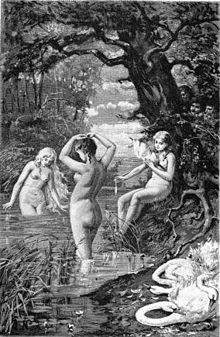Völundarkviða


Völundarkviða (Völundr's poem, the name can be anglicized as Völundarkvitha, Völundarkvidha, Völundarkvida, Volundarkvitha, Volundarkvidha or Volundarkvida) is one of the mythological poems of the Poetic Edda. The term kviða derives from the verb kveða (or kvœtha in Old Swedish[dubious ]) which carried the sense of "to say, to tell" and "to sing" at the same time.[1]
Synopsis
The poem relates the story of the artisan Völundr, also known as Wayland the Smith. In the poem, he is called "prince of the elves" (vísi álfa) and "one of the álfar" or "leader of álfar" (álfa ljóði). He is also mentioned as one of the three sons of the king of the Finns in the poem. His wife Hervör-Alvitr, a valkyrie, abandons him after nine years, and he is later captured by Níðuðr, a petty-king of Närke (Sweden) greedy for his gold. Völundr is hamstrung and put to work on an island making artifacts for the king. Eventually he finds means of revenge and escape. He kills Niðuðr's sons, impregnates his daughter and then flies away laughing.
The poem is appreciated for its evocative images.
- In the night went men,
- in studded corslets,
- their shields glistened
- in the waning moon.
Völundarkviða 6, Thorpe's translation

The Völundr myth appears to have been widespread among the Germanic peoples. It is also related in the Þiðrekssaga af Bern (Velents þáttr smiðs) and it is alluded to in the Old English poem The Lament of Deor. It is moreover depicted on a panel of the 7th century Anglo-Saxon Franks Casket and on the 8th century Gotlandic Ardre image stone VIII.
The poem is preserved in its entirety among the mythological poems of the Codex Regius and the beginning of the prose prologue is also found in the AM 748 I 4to fragment.
References
- Dronke, Ursula (Ed. & trans.) (1997). The Poetic Edda, vol. II, Mythological Poems. Oxford: Clarendeon. ISBN 0-19-811181-9.
- Thorpe, Benjamin. (Trans.). (1866). Edda Sæmundar Hinns Froða: The Edda Of Sæmund The Learned. (2 vols.) London: Trübner & Co. 1866. Reprinted 1906 as Rasmus B. Anderson & J. W. Buel (Eds.) The Elder Eddas of Saemund Sigfusson. London, Stockholm, Copenhagen, Berlin, New York: Norrœna Society. Available online at Google Books. Searchable graphic image version requiring DjVu plugin available at University of Georgia Libraries: Facsimile Books and Periodicals: The Elder Eddas and the Younger Eddas.
External links
English translations
- Völundarkvitha Translation and commentary by Henry Adams Bellows
- Bellows' translation with facing page Old Norse text
- [1] Translation by Benjamin Thorpe
- Völundarkviða Translation by W. H. Auden and P. B. Taylor
Old Norse editions
- Völundarkviða Sophus Bugge's edition of the manuscript text
- Völundarkviða Guðni Jónsson's edition with normalized spelling
